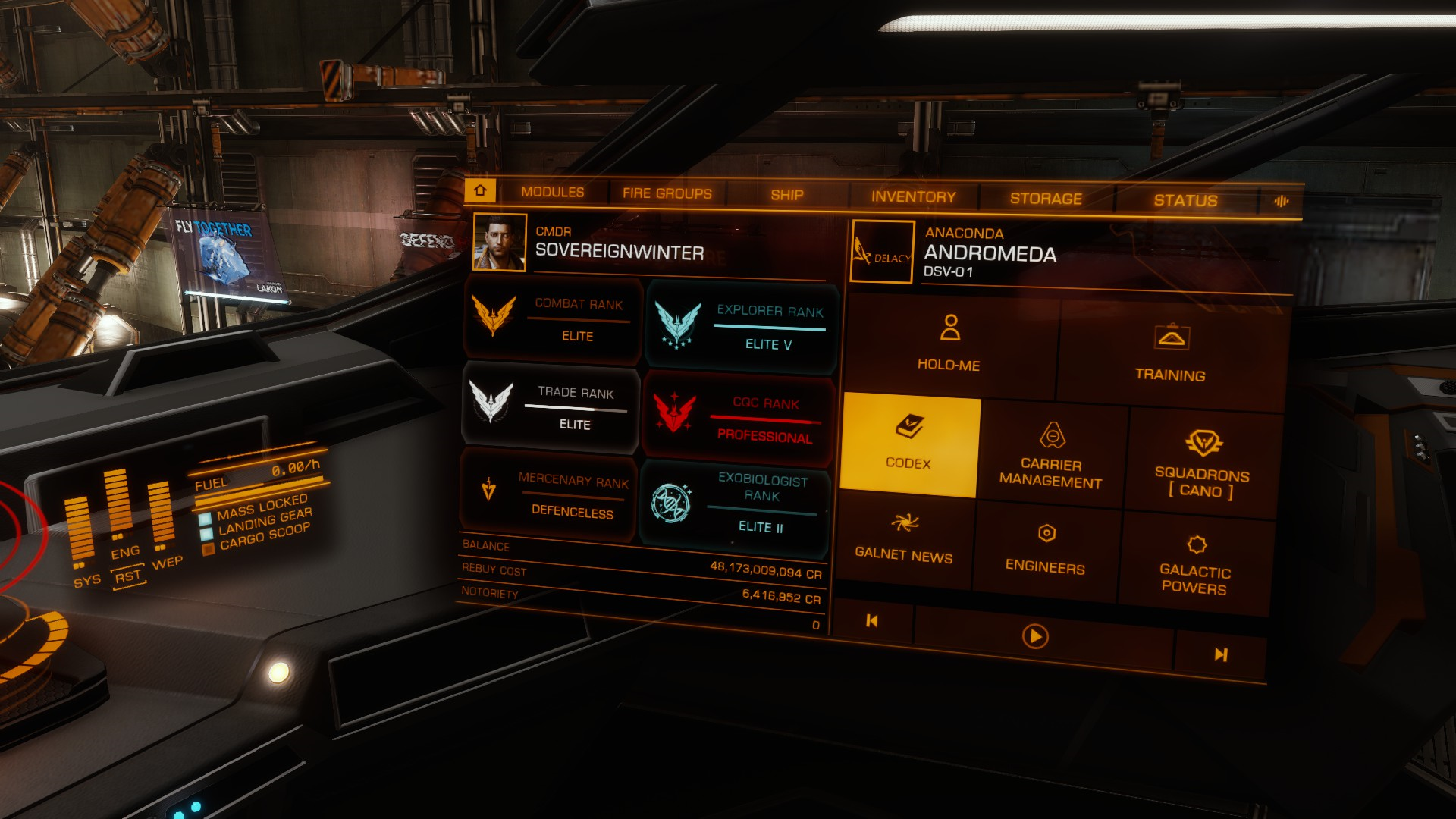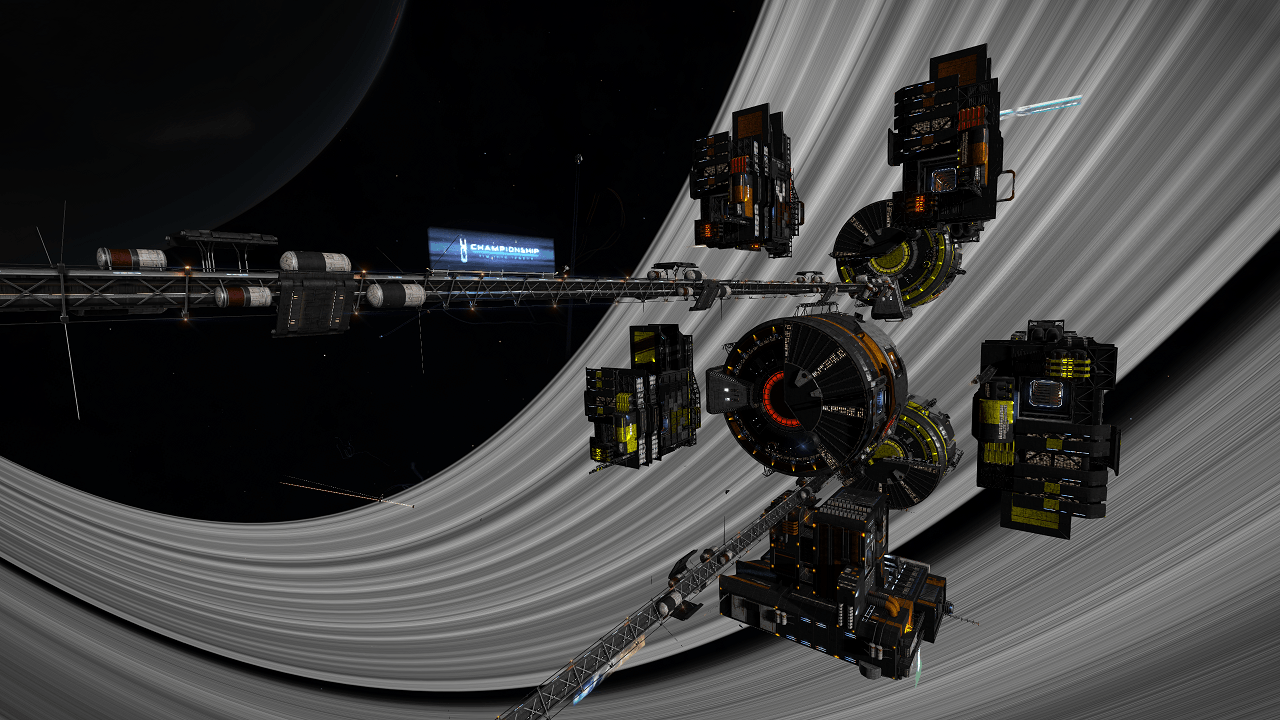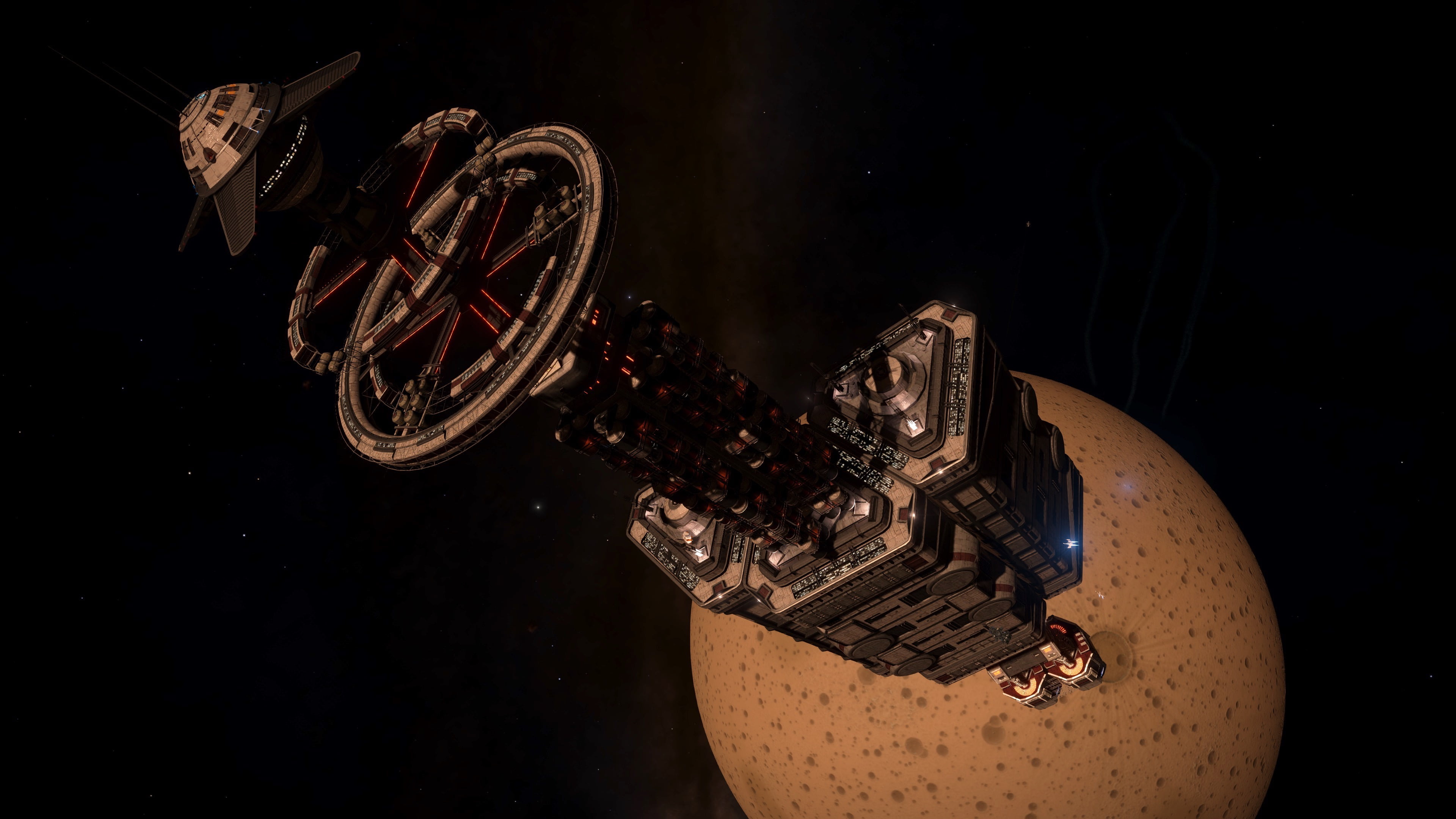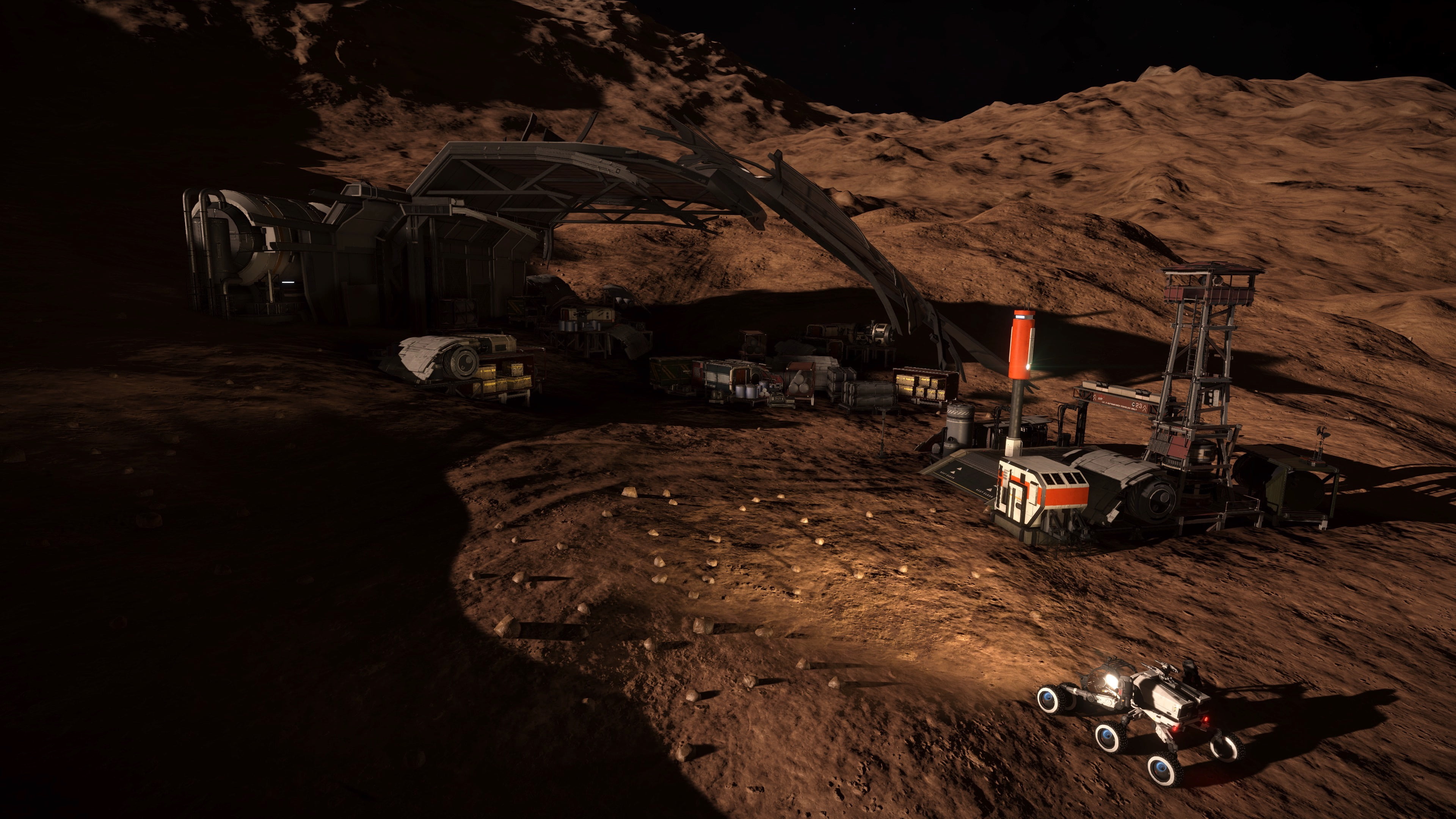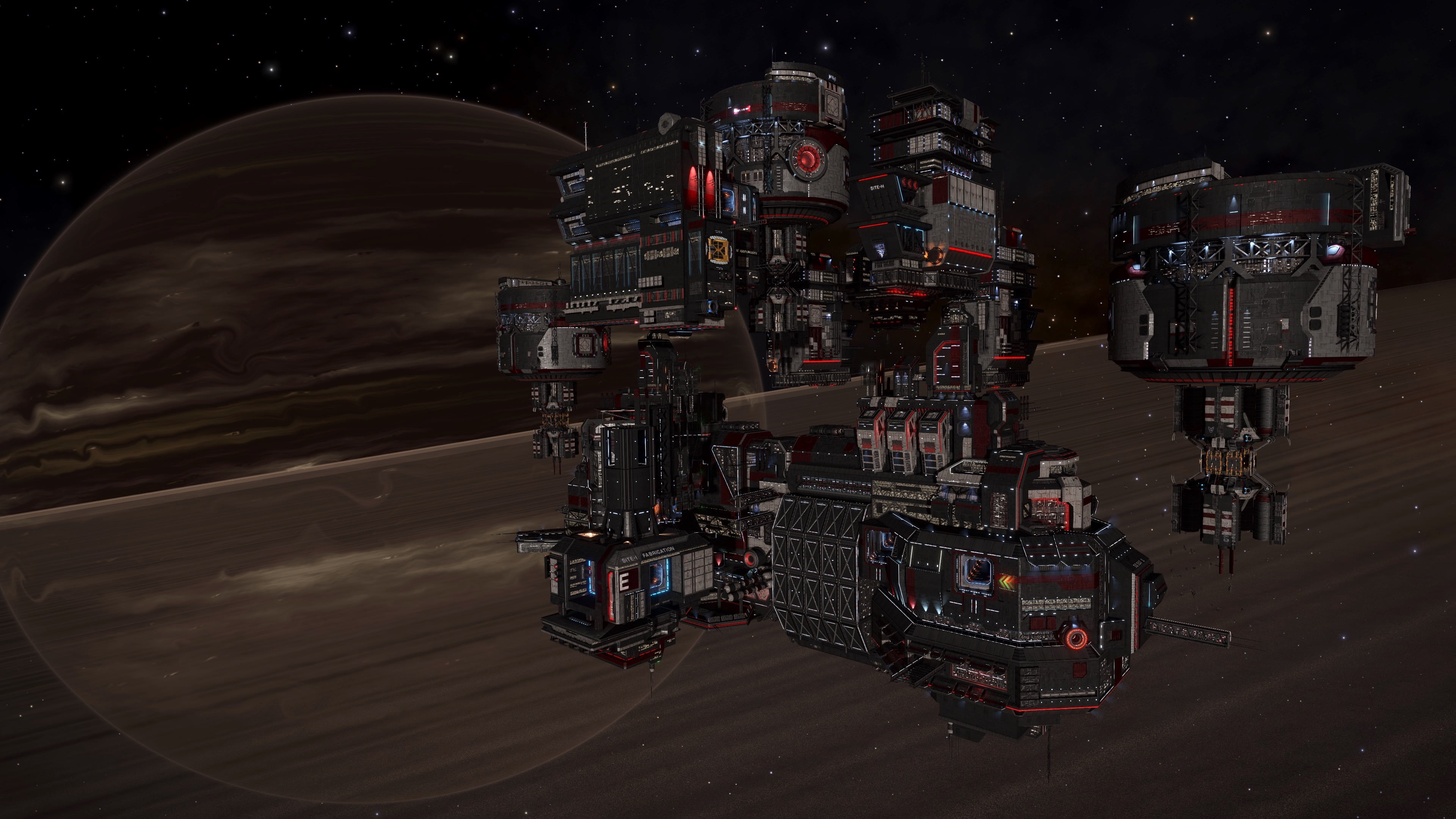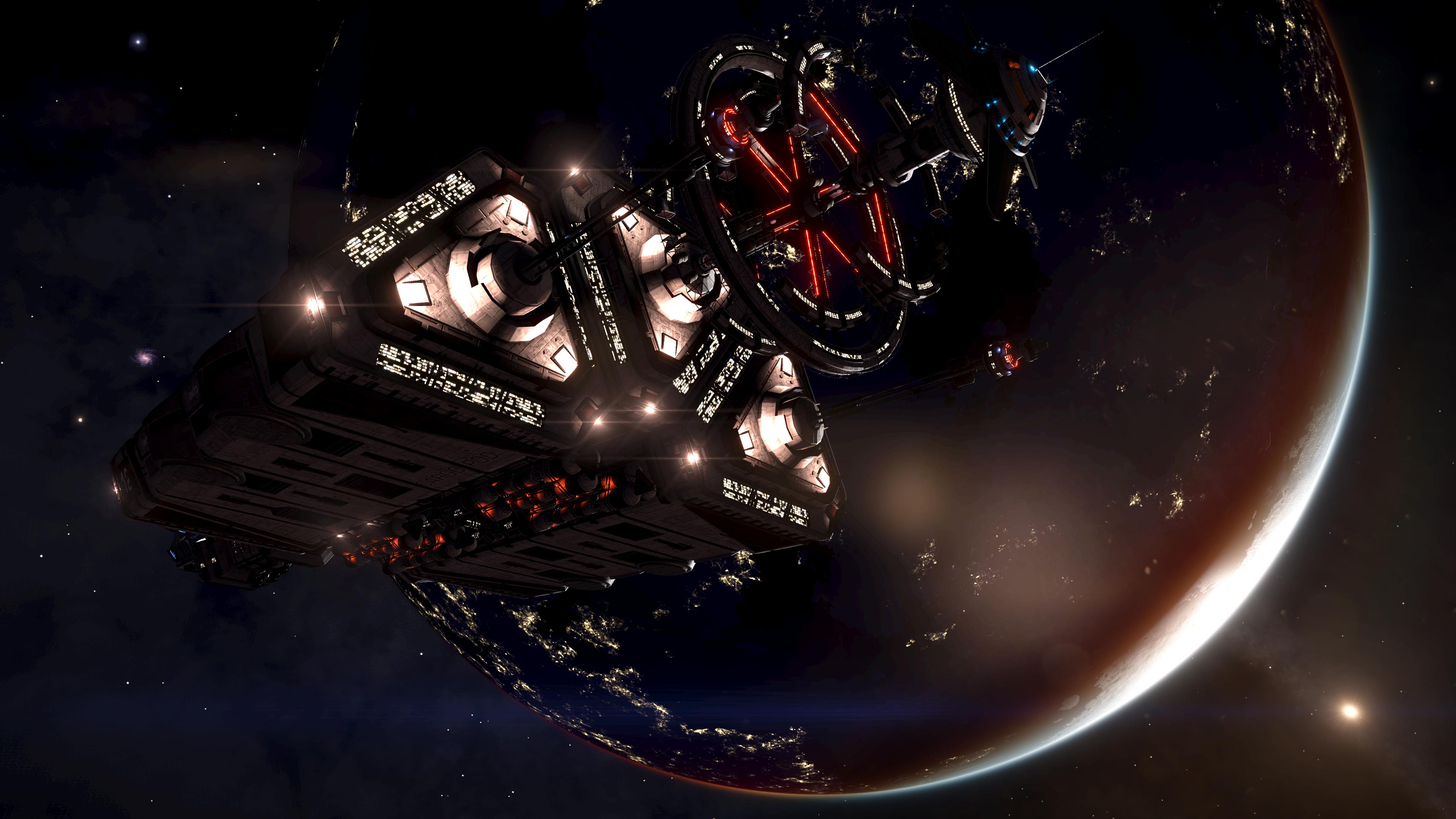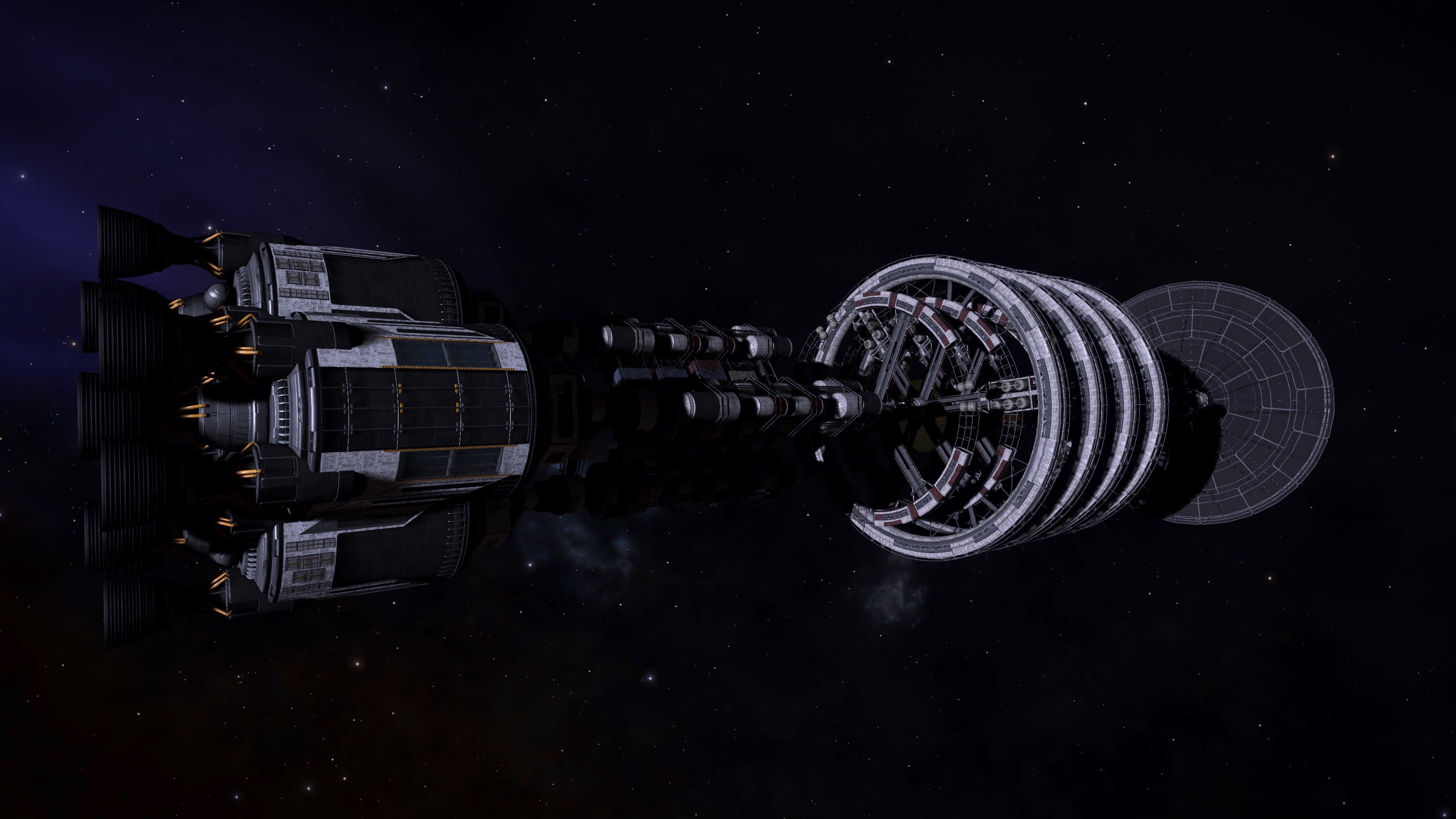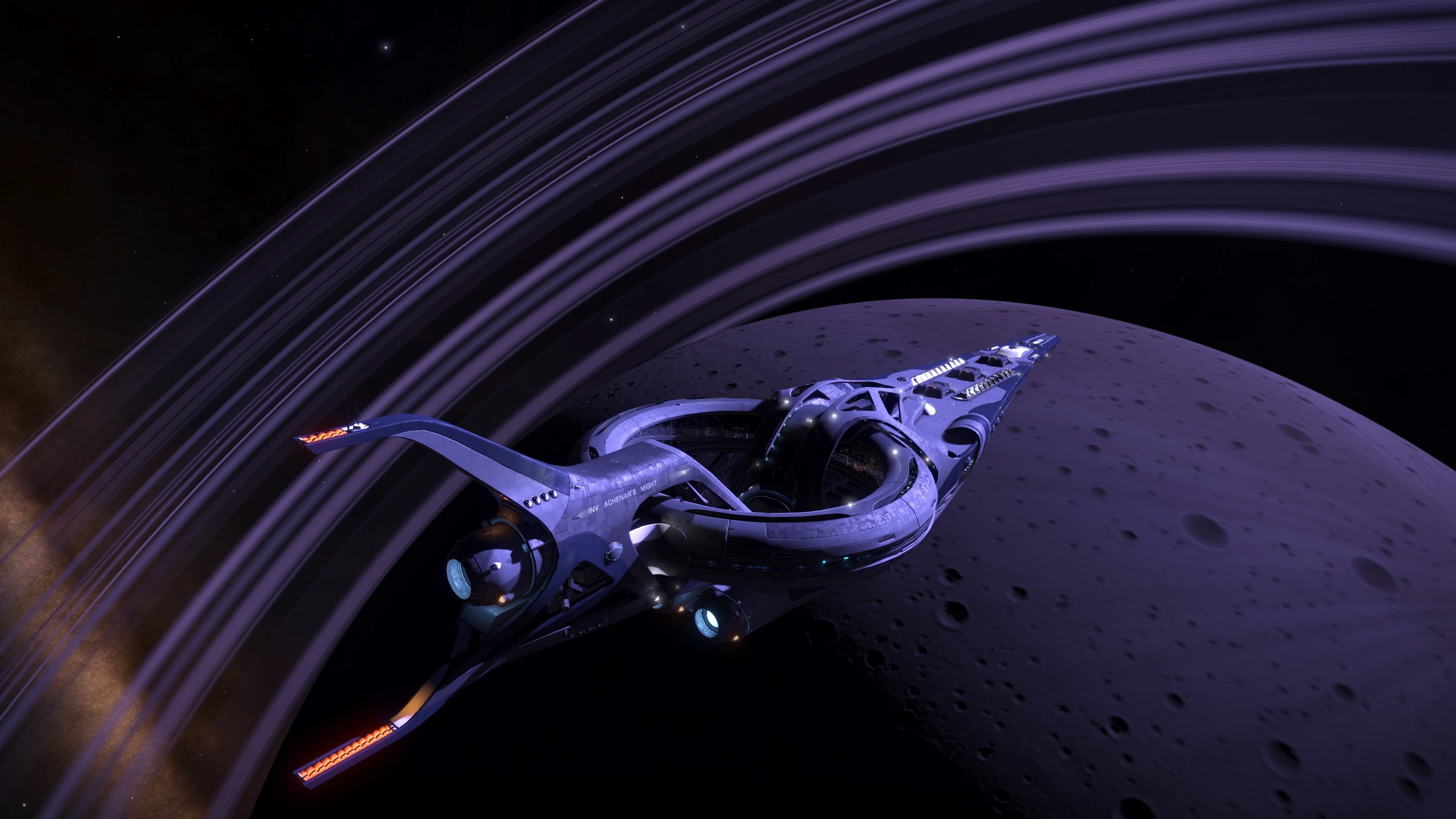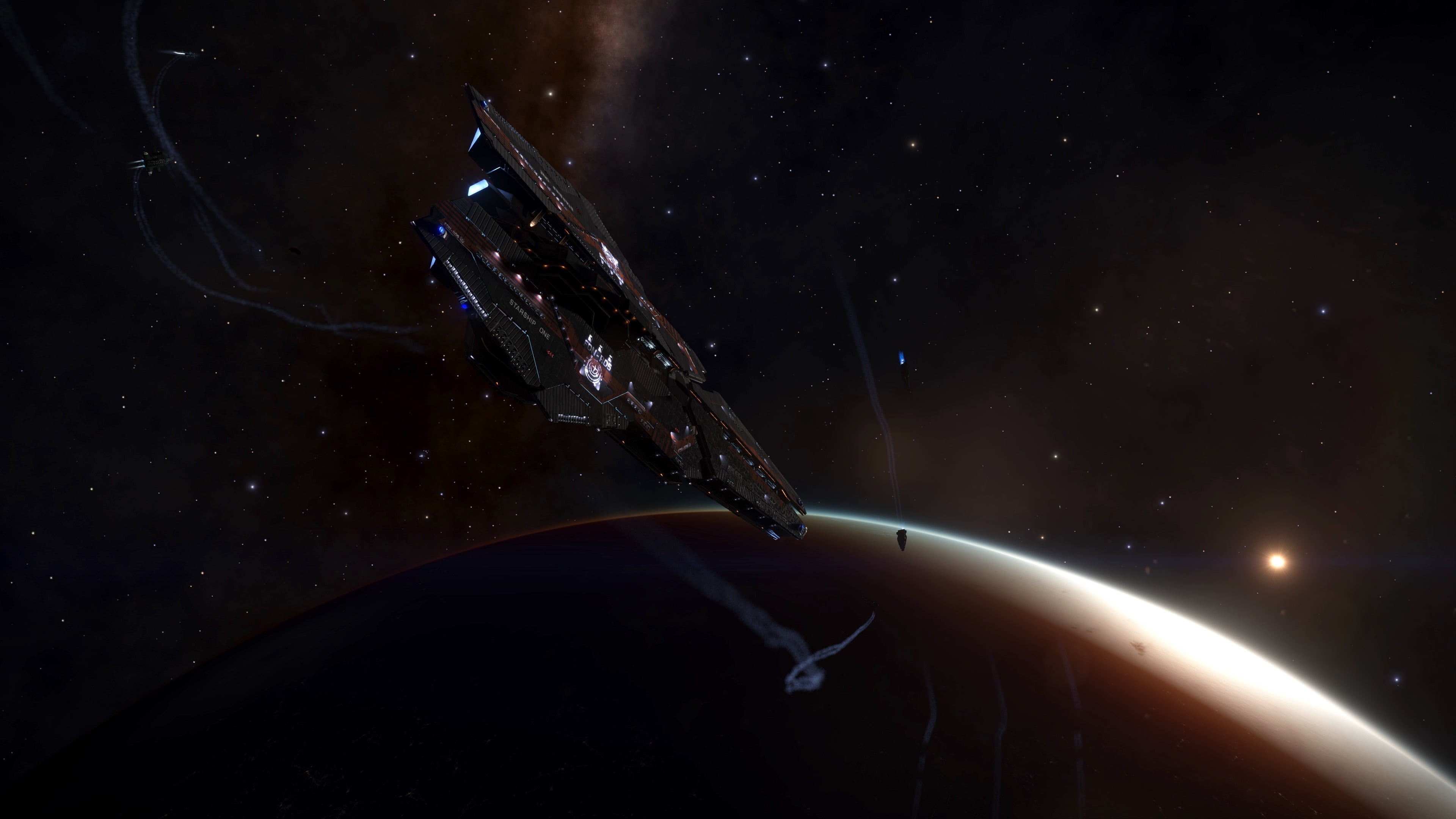The Scriveners are a nomadic clan of scribes, scientists and knowledge-keepers. They travel through deep space onboard a self-sufficient Dredger-class bulk cruiser, completely isolated from human civilization and the politics of the bubble.
History
According to information provided by spokespersons of the Orion University, the history of the Scrivener Clan begins in the year 3088, when the Dredger J-403 was commissioned as part of a research fleet of the Scrivener College. Said academic institute was absorbed by the Orion University in 3125. The Dredgers activity in the 37 years between its departure and the College’s takeover by Orion University remains a mystery, and it is unknown why the vessel never returned, what happened to the rest of the fleet, or what led to the Scriveners cutting their ties to their parent institute. Although much speculation exists and stories about the Scriveners as well as the other Dredger Clans circulate throughout the bubble, nothing of it can be taken as fact, as the Scriveners were, for a long time, very successful at remaining intangible.
“It’s well known that there are many travelling communities – groups of people who prefer to live on the move rather than settle anywhere. Proudly independent, they survive on the fringes of civilization and tend to avoid interacting with the authorities. Those commonly known as the Dredger Clans are among the most successful.”
-Erik Gunnarson
After 219 years of mystery, the recent history of the Scrivener Clan picks up on the 8th of April 3307. On this day, independent commanders reported receiving an encrypted signal with anonymous instructions from a communications beacon stored onboard the Adamastor in the Chukchan system. Apparently, the signal was being rebroadcasted and originated at the Hesperus, the sister-ship of the Adamastor, which reactivated an emergency ping system after being approached by a then unknown object in an unknown location.
Efforts by authorities to trace and decipher the signal proved unsuccessful, however, independent commanders and the Canonn Interstellar Research Group, with the help of a decryption key provided by the mysterious figure known as “Salvation”, managed to track down the original signal in Perseus Dark Region KC-V C2-2, with CMDR Marxanthius being the first to confirm visual contact.
As it turned out, the automatic emergency system of the Hesperus was triggered by the Scriveners, who found the ghost ship drifting in an asteroid cluster and began salvaging it for data and technology. Four encoded data files from the Hesperus resisted upload and were possible to retrieve by independent pilots from uplinks located on the Dredger due to a gap in the antiquated firewall. These data transfers were labeled “Knowledge Core Inputs: VF-77655657, VF-77655658, VF-77655770, VF-77655771” respectively, the former two originating from the Hesperus’ on-board computer and the latter two having been retrieved from the internal drive of an empty EVA suit by Research-Sergeant Indesh. The Scriveners responsible for the processing of the salvaged data were named as Datagrapher Authell and Datagrapher Biblian, and apparently were subordinate to Lector-General Calligore, who ordered the encrypted files to be transferred to a so-called ‘Strategy College’. The Dredger was broadcasting the following message:
Salvage Claim
This is a message from the Scriveners Clan to all ships arriving in this area.
We claim this megaship as legitimate salvage. Our scouts have already inspected its interior and taken any useful cargo that remained. Its data drives have been removed and are being incorporated into the Knowledge Core that our people have sustained for decades.
The remains will be converted into raw materials for our use. The megaship no longer has any value to you or anyone else.
Be warned! The Scriveners Clan does not communicate with outsiders. We will not initiate hostile action, but you are cautioned to not interfere with our procedures.
On 27th April of 3307, Francesca Wolfe of the Wallglass Investigations Agency provided additional information on the Scrivener Clan and explained their motives, which included the strong desire to acquire knowledge and feed it into their so-called “Knowledge Core”. This artifact, whether a glorified data storage, a long forgotten AI, or something else entirely, is guarded by them jealously and with fervor, being part of the reason the clan shuns outsiders.
On the 9th of July 3307 the Scrivener Dredger left the system, after remaining in an increasing center of attention for three months. Speculation arose as to why the Scriveners left the Hesperus ghost ship prematurely, but it was widely assumed that they escaped the growing public interest, based on their secretive nature.
On the 13th October 3307, months after the departure of the Scriveners, Orion University – the largest independent educational institution in the core systems – publicly laid claim to the Dredger J-403, after having unearthed historical records proving that after their takeover of the Scrivener College in 3125, the vessel is legally considered their commercial property. The university immediately took action and partnered with ‘Deep Space Mining’ in Ring Mine, 2Mass J03291977+3124572, offering 20 million credits to every commander willing to deliver them information about the Scriveners’ current whereabouts and an additional payment of 250 million credits for the first ten pilots. A tip-off by a lone miner from the area proved invaluable, limiting the search area considerably. It took independent pilots only one day to locate the dredger in Oochost PC-C C29-0, where it was found drifting above an asteroid ring by Cmdr Anoobvia, possibly refueling. Scanning the first uplink of the dredger yielded the following information, authored by Dean-Colonel Thesilius:
Department: Strategy College
Topic: Summary Report – Salvage Operation T009776/C
Content: The processing of imported materials from megaship H002255 has now entered its final phase. The last batch of heavy metals is en route to our matter-recycling printers, and all onboard data has been uploaded to the Knowledge Core.
Over 88% of all components removed from the megaship were suitable for addition to our equipment stores. Compatibility issues are minor since H002255 originated from the same period as when our dredger was commissioned, approximately 440 semesters ago.
As a result, engineering repair capacity is projected to improve by 34%.
Priority has been assigned to the recent infrastructure breaches in sections C9 and C10.
Atmospheric containment in the citizen campuses suffered multiple localized failures, but resulted in only a 0.8% decrease in population.
Salvaging procedures were halted before commencement of stage seven (hull deconstruction) on orders from Lector-General Calligore. The continual influx of outsider ships in the system had increased risk assessments beyond tolerable levels.
My team has investigated reports that several uploads from the megaship became temporarily available via external ports. The disruption of our firewall grid was caused by the Knowledge Core being unable to auto-transcript four encrypted files. All data nodes have been locked to prevent any further access by outsiders, and the security risk remains low.
Upon scanning the remaining uplinks, pilots were met with the following warning:
Status: Inactive
Drive input mode: Locked
Proximity alert: Type D [unidentified vessel]Input detection: Positive
Signal preset 01D transmitting…
“This is a message from the Scriveners Clan. You are not authorized to access our systems. Our vessel is off limits to all outsiders and no communication is permitted. For your own safety, remove your ship from our vicinity immediately. Consider this to be an official warning.
Vice Chancellor Leland Pettigrew, head of the operation for Orion University, congratulated the pilots involved in the search and announced that megaship would be dispatched shortly to take ownership and arrange repatriation for the occupants. It is perhaps needless to say, that the self-isolating, secretive clan did not welcome the news. The megaship of the Orion University, ‘Scientia Aeterna’ arrived, but eye-witnesses, including countless curious commanders and Canonneers observed that the Scrivener tribe refused to allow Orion University to repossess the ancient vessel – their home. Requests to communicate were ignored and and pushy pilots were met with sealed airlocks and an electrified hull. Orion University, in an attempt to solidify their claim, used a series of override codes, effectively disabling the dredger’s hyperdrive and potentially other subsystems.
The Scriveners possess something that they refer to as a Knowledge Core, which contains everything that this scholarly society has learned during its long voyage. What discoveries might this database contain? And how far will the university go to get their hands on it?
-Casey Kilpatrick, freelance reporter
The ensuing standoff between the Scriveners and the Orion University made headlines and caught the attention of the civil rights organization “Advocacy”. On the 1st of November 3307 the Advocacy challenged the Orion University, explaining that it had no right to deprive over ten thousand people of their only home.
For centuries, there has been widespread legislation to protect remote communities from cultural contamination. These laws apply to micro-societies, such as those found aboard generation ships, that evolved in isolation.
-Rhiannon Grady, director of Advocacy
Professor Elizabeth Perez, head of anthropology at Orion University, refused to acknowledge the demands and pointed out that the dredger’s age and condition made it a hazardous environment, pushing for an immediate evacuation. The deadlock continued, with the Scientia Aeterna having halted the attempts to get access to the dredger vessel, but not having withdrawn the remote hyperdrive-override. With the situation onboard the dredger worsening with each passing day, the Canonn Council, seeking a compromise to save the Scriveners, offered to buy the vessel from the Orion University, allowing the Scriveners to continue their journey with the dredger, on the condition that they would share the contents of the Knowledge Core with the public. Neither party reacted to the offer, while discussions about the nature of property, civil rights and cultural contamination echoed throughout the scientific community.
[…] two centuries of isolation have instilled this academia-focused society with a pathological need to protect its research. They are no more likely to cooperate than a deeply religious nation asked to hand over its most holy artefact.
-Casey Kilpatrick, freelance reporter
As days passed, the situation became unbearable to onlookers and everyone involved. On the 15th of November 3307 independent observers reported malfunctions in the vessel’s power and life support systems. The Scriveners, being deprived of food, water and materials to maintain the dredger’s vital systems, but unwilling to break their siege mentality, were facing possible extinction. Reporter Casey Kilpatrick, who was following the case closely, commented that Orion University “might inherit the dredger, but it will be a ship of the dead”. Canonn, feeling connected to the Scriveners in heart and soul, issued a strong worded appeal, condemning the modus operandi of Orion University, and requesting all independent pilots to feed crucial supplies and materials directly into the dredgers maw. Three days later, on November 18th, two competing campaigns began in the HIP 43670 system. While Orion University partnered with ‘Independent HIP 43670 Labour’ to collect data and donate it to the Scriveners, in exchange for the allowance to accompany them on their journey, the supporters of the Scriveners Clan, including the Advocacy, partnered with ‘Alliance of HIP 42371’ to collect materials needed to perform vital repairs to the dredger and bypass the ancient components affected by the system override. A fierce competition ensued, with thousands of independent pilots flocking to the HIP 43670 system to support one of the parties. Naturally, Canonn joined the initiative to repair the dredger: under guidance of a handful experienced commanders and with the support of dozens others, a highly organized fleet of over twenty-two carriers under the tag [SCI] was dispatched, facilitating a steady transport of the requested materials, joining forces with hundreds of tireless independent pilots fighting for the Scriveners’ freedom.
On the 25th of November 3307, after a head-to-head race against the supporters of the Orion University, the initiative finished with full success. The Scriveners were free. Vice Chancellor Leland Pettigrew confirmed the university would honor the outcome and withdraw the claim over the dredger. One week later, December 3rd, the repairs of the dredger were completed, and the clan departed to an unknown destination. The scientific community, for the most part, respected the Scriveners’ wish for privacy and did not undertake further attempts to locate and track them. Nonetheless, many were left wondering what secrets they have taken with them on their never-ending journey.
Characteristics
Dredger-class bulk cruisers are the sharks of space – they must always keep moving, constantly gathering raw materials to synthesize into fuel, air and other resources.
-Casey Kilpatrick, freelance reporter
The Scriveners occupy a Dredger-class bulk carrier – a self-sustaining megaship outfitted with a gargantuan grinder-maw, capable of crushing salvage and rock, which are then further processed to valuable raw materials.
This process is aided by matter-recycling printers. Functional components are refurbished and added to equipment stores. Aside from supplies and parts, they harbor an interest in knowledge they can gather from drives and data storages. Based on their primary profession, it can be assumed that they have a certain degree of expertise in data processing, cryptography and linguistics. The Dredger vessel exhibits a maximum jump range of 500 lightyears and most likely uses Tritium as fuel.
Society
These dredgers are now a type of generation ship. Each hosts tens of thousands of people, whose cultures have evolved – or devolved – over decades or centuries. Some are true loners while others have formed alliances, or occasionally gather to increase their gene pools.
-Erik Gunnarson
The Scrivener Clan consists of over ten thousand people who descended from the original crew of the Dredger J-403. Little is known about their current culture and society but following Francesca Wolfe’s suggestion, the titles of the Scriveners imply their culture is a merger of scholastic and military. So far, the following titles have been registered: Lector-General, Dean-Colonel, Research-Sergeant, Datagrapher. While some of them, like Lector-General and Dean-Colonel correspond to command and administration, and the title of Research-Sergeant implies field operations, others like Datagrapher seem to refer to less militaristic and more scholastic roles, only responsible for data processing onboard the dredger. It becomes clear that to maintain proper functioning in an isolated community, the Scrivener society has developed strong hierarchical structures.
The Scriveners are adamant in their calling to protect the Knowledge Core, the central piece of their culture, to the point of risking extinction to guard its contents. We can only speculate if the entirety of the clan shares this mentality, or whether it is a policy enforced by the higher ranks of their hierarchy. Nonetheless, the attainment of knowledge and data seems to constitute their main goal and core belief. The clan’s crest seems to be inspired by old-earth mysticism, specifically the Metatron cube, which, according to some beliefs, represents knowledge, and the striving for knowledge that was excluded from human experience.
Due to their extreme seclusion, it is currently unknown whether the Scriveners partake in Dredger Clan gatherings, and if not, how they maintain genetic diversity in their population.
This article was written by Commander M. V. Coehoorn, with special thanks to Commanders Scott Riggs, Marxanthius, LilacLight and Darwin.



